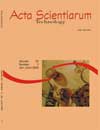<b>Use of vegetation for recovering degraded urban areas</b> - DOI: 10.4025/actascitechnol.v26i1.1555
DOI:
https://doi.org/10.4025/actascitechnol.v26i1.1555Keywords:
vegetação urbana, áreas degradadas, atividade antrópicaAbstract
The aim of this study is to systematize both the information and procedures that guide the activities related to the recovery of degraded areas. Firstly, the anthropic activities in urban areas and their consequences are exposed, classifying those that change the environment in 9 groups: sanitation work, urbanization, transport and transmission, mineral extraction, combined agriculture and stock raising, trade and services, electric light and power stations, terminal installations and transformation industries. In the same way, the physical environment processes are classified, considering the atmosphere, hydrosphere, and lithosphere as well. Finally, the last part of this study is dedicated to the use of vegetation and its influence on the control of the environmental impacts development, approaching some aspects such as the ecological succession issue, the choice of vegetal species and plantation methodsDownloads
Download data is not yet available.
Downloads
Published
2008-03-31
How to Cite
Angelis Neto, G. D., Angellis, B. L. D. D., & Oliveira, D. S. de. (2008). <b>Use of vegetation for recovering degraded urban areas</b> - DOI: 10.4025/actascitechnol.v26i1.1555. Acta Scientiarum. Technology, 26(1), 65–73. https://doi.org/10.4025/actascitechnol.v26i1.1555
Issue
Section
Civil Engineering
License
DECLARATION OF ORIGINALITY AND COPYRIGHTS
I Declare that current article is original and has not been submitted for publication, in part or in whole, to any other national or international journal.
The copyrights belong exclusively to the authors. Published content is licensed under Creative Commons Attribution 4.0 (CC BY 4.0) guidelines, which allows sharing (copy and distribution of the material in any medium or format) and adaptation (remix, transform, and build upon the material) for any purpose, even commercially, under the terms of attribution.
Read this link for further information on how to use CC BY 4.0 properly.
0.8
2019CiteScore
36th percentile
Powered by 



0.8
2019CiteScore
36th percentile
Powered by 

















8.png)




